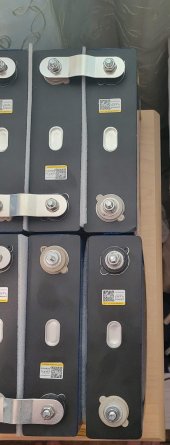I recently got my order of 16 90AH cells, and I was excited to start testing with them.
Summary: I made some very stupid mistakes.
Capacity testing an 8s pack of raw cells, one of the cells dropped to below 1 volt, and is now swollen like a balloon, say 2-4mm on each side.
Is it reasonable to use 7s or 15s bms with a charge controller, or do I need to try to find a replacement that matches?
Longer version
I have some experience building batteries from used 18650 cells, to make portable power supplies for things like my boombox, laptop, etc. But I have never worked with LiFePo4 before.
I have been preparing to get a workshop/home-office built in my yard, and wanted to see if I could set up solar panels on the roof, and try to run it off solar with battery backup. I ordered 16 90AH cells, and they arrived recently.
I picked 8 out to make a 24v pack, and they were all at 3.2v, so I went ahead and put them in series, and started to charge them up at 28.8v.
I had completely forgotten that with lifepo, even though they are the same voltage, they can be at drastically different SoC. ( This could be the reason, or one cell could have just been bad )
After some time, my charger was in CV mode and the current had dropped, so I took the batteries off, and got ready to capacity test them, assuming the batteries would be around 90% SoC.
When I started the capacity test, everything started out well, but after 10 hours, I noticed the voltage had dropped lower than I expected. I started checking each cell, and one of them was below 1v, and the reset were all around the same voltage, 2.8 or similar.
I started a slow charge of that cell, and I didn't notice if it happened during discharge or recharging but that cell swelled up dramatically. To the point where I would not trust it at my level of experience with these cells.
I have read plenty of posts that discuss compression, and possibly draining it to see if it will debloat and so-on, but most likely I simply do not want to deal with this cell.
I wasn't able to find any posts talking about using 7s or 15s as the source for a 48v or 24v inverter or all-in-one. I know that plenty of solar charge controllers have programmable voltage cuttofs, so I wanted to ask about anyone's experience in this situation.
There are probably a thousand questions I don't even know to ask, so any other thoughts on this would be appreciated.
Summary: I made some very stupid mistakes.
Capacity testing an 8s pack of raw cells, one of the cells dropped to below 1 volt, and is now swollen like a balloon, say 2-4mm on each side.
Is it reasonable to use 7s or 15s bms with a charge controller, or do I need to try to find a replacement that matches?
Longer version
I have some experience building batteries from used 18650 cells, to make portable power supplies for things like my boombox, laptop, etc. But I have never worked with LiFePo4 before.
I have been preparing to get a workshop/home-office built in my yard, and wanted to see if I could set up solar panels on the roof, and try to run it off solar with battery backup. I ordered 16 90AH cells, and they arrived recently.
I picked 8 out to make a 24v pack, and they were all at 3.2v, so I went ahead and put them in series, and started to charge them up at 28.8v.
I had completely forgotten that with lifepo, even though they are the same voltage, they can be at drastically different SoC. ( This could be the reason, or one cell could have just been bad )
After some time, my charger was in CV mode and the current had dropped, so I took the batteries off, and got ready to capacity test them, assuming the batteries would be around 90% SoC.
When I started the capacity test, everything started out well, but after 10 hours, I noticed the voltage had dropped lower than I expected. I started checking each cell, and one of them was below 1v, and the reset were all around the same voltage, 2.8 or similar.
I started a slow charge of that cell, and I didn't notice if it happened during discharge or recharging but that cell swelled up dramatically. To the point where I would not trust it at my level of experience with these cells.
I have read plenty of posts that discuss compression, and possibly draining it to see if it will debloat and so-on, but most likely I simply do not want to deal with this cell.
I wasn't able to find any posts talking about using 7s or 15s as the source for a 48v or 24v inverter or all-in-one. I know that plenty of solar charge controllers have programmable voltage cuttofs, so I wanted to ask about anyone's experience in this situation.
There are probably a thousand questions I don't even know to ask, so any other thoughts on this would be appreciated.




